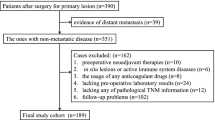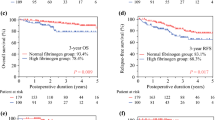Abstract
Background
Coagulation and inflammation play important roles in tumor progression. This study aimed to explore the prognostic impact of combined analysis of fibrinogen and neutrophil-to-lymphocyte (NLR) ratio (F-NLR score) in locally advanced rectal cancer (LARC) receiving preoperative chemoradiotherapy (pCRT) and radical surgery.
Method
Totally 317 patients were included. X-tile analysis was used to determine the optimal cutoff values of preoperative fibrinogen and NLR. F-NLR scores were defined as 2 (both high fibrinogen and NLR), 1 (one of these abnormalities), or 0 (neither abnormality). Time-dependent ROC analysis was used to evaluate the predictive accuracy of fibrinogen, NLR, and F-NLR score. Cox regression analysis was performed to evaluate the prognostic impact of the F-NLR score. A predictive nomogram for disease-free survival (DFS) was developed and validated internally.
Results
One hundred and seventeen (36.9%), 156 (49.2%), and 44 (13.9%) patients had F-NLR score of 0, 1, and 2, respectively. Higher F-NLR score was associated with poorly differentiated tumors, deeper tumor invasion, lymph node metastasis, and more advanced pTNM stage (all P < 0.05). The 5-year OS rates in the F-NLR 0, 1, and 2 groups were 93.6%, 87.3%, and 68.4%, respectively (P < 0.001), while the 5-year DFS rates were 91.8%, 76.8%, and 56.1%, respectively (P < 0.001). Cox regression analysis demonstrated that F-NLR score (F-NLR 1, HR = 2.021, P = 0.046; F-NLR 2, HR = 3.356, P = 0.002), pTNM stage III (HR = 3.109, P = 0.009), and circumferential resection margin (CRM) involvement (HR = 3.120, P = 0.021) were independently associated with DFS. A nomogram for DFS was developed (C-index 0.708).
Conclusion
F-NLR score is a promising predictor for disease recurrence in LARC patients after pCRT.


Similar content being viewed by others
References
van Gijn W, Marijnen CA, Nagtegaal ID et al (2011) Preoperative radiotherapy combined with total mesorectal excision for resectable rectal cancer: 12-year follow-up of the multicentre, randomised controlled TME trial. Lancet Oncol 12:575–582
Sauer R, Liersch T, Merkel S et al (2012) Preoperative versus postoperative chemoradiotherapy for locally advanced rectal cancer: results of the German CAO/ARO/AIO-94 randomized phase III trial after a median follow-up of 11 years. J Clin Oncol 30:1926–1933
Rodel C, Graeven U, Fietkau R et al (2015) Oxaliplatin added to fluorouracil-based preoperative chemoradiotherapy and postoperative chemotherapy of locally advanced rectal cancer (the German CAO/ARO/AIO-04 study): final results of the multicentre, open-label, randomised, phase 3 trial. Lancet Oncol 16:979–989
Hanahan D, Weinberg RA (2011) Hallmarks of cancer: the next generation. Cell 144:646–674
Templeton AJ, McNamara MG, Seruga B et al (2014) Prognostic role of neutrophil-to-lymphocyte ratio in solid tumors: a systematic review and meta-analysis. J Natl Cancer Inst 106:u124
Li MX, Liu XM, Zhang XF et al (2014) Prognostic role of neutrophil-to-lymphocyte ratio in colorectal cancer: a systematic review and meta-analysis. Int J Cancer 134:2403–2413
Falanga A, Marchetti M, Vignoli A (2013) Coagulation and cancer: biological and clinical aspects. J Thromb Haemost 11:223–233
Wang J, Liu H, Shao N et al (2015) The clinical significance of preoperative plasma fibrinogen level and platelet count in resectable esophageal squamous cell carcinoma. World J Surg Oncol 13:157. https://doi.org/10.1186/s12957-015-0543-4
Huang G, Jiang H, Lin Y et al (2018) Prognostic value of plasma fibrinogen in hepatocellular carcinoma: a meta-analysis. Cancer Manag Res 10:5027–5041
Zhong H, Qian Y, Fang S et al (2018) Prognostic value of plasma fibrinogen in lung cancer patients: a meta-analysis. J Cancer 9:3904–3911
Kawai K, Kitayama J, Tsuno NH et al (2011) Hyperfibrinogenemia after preoperative chemoradiotherapy predicts poor response and poor prognosis in rectal cancer. Int J Colorectal Dis 26:45–51
Lu K, Zhu Y, Sheng L et al (2011) Serum fibrinogen level predicts the therapeutic response and prognosis in patients with locally advanced rectal cancer. Hepatogastroenterology 58:1507–1510
Arigami T, Uenosono Y, Matsushita D et al (2016) Combined fibrinogen concentration and neutrophil-lymphocyte ratio as a prognostic marker of gastric cancer. Oncol Lett 11:1537–1544
Kijima T, Arigami T, Uchikado Y et al (2017) Combined fibrinogen and neutrophil-lymphocyte ratio as a prognostic marker of advanced esophageal squamous cell carcinoma. Cancer Sci 108:193–199
Wang H, Zhao J, Zhang M et al (2018) The combination of plasma fibrinogen and neutrophil lymphocyte ratio (F-NLR) is a predictive factor in patients with resectable non small cell lung cancer. J Cell Physiol 233:4216–4224
Camp RL, Dolled-Filhart M, Rimm DL (2004) X-tile: a new bio-informatics tool for biomarker assessment and outcome-based cut-point optimization. Clin Cancer Res 10:7252–7259
Zheng S, Shen J, Jiao Y et al (2009) Platelets and fibrinogen facilitate each other in protecting tumor cells from natural killer cytotoxicity. Cancer Sci 100:859–865
Seth R, Tai LH, Falls T et al (2013) Surgical stress promotes the development of cancer metastases by a coagulation-dependent mechanism involving natural killer cells in a murine model. Ann Surg 258:158–168
Perisanidis C, Psyrri A, Cohen EE et al (2015) Prognostic role of pretreatment plasma fibrinogen in patients with solid tumors: a systematic review and meta-analysis. Cancer Treat Rev 41:960–970
Foley JH, Conway EM (2016) Cross talk pathways between coagulation and inflammation. Circ Res 118:1392–1408
Steinbrecher KA, Horowitz NA, Blevins EA et al (2010) Colitis-associated cancer is dependent on the interplay between the hemostatic and inflammatory systems and supported by integrin alpha(M)beta(2) engagement of fibrinogen. Cancer Res 70:2634–2643
McMillan DC (2013) The systemic inflammation-based glasgow prognostic score: a decade of experience in patients with cancer. Cancer Treat Rev 39:534–540
Desgrosellier JS, Cheresh DA (2010) Integrins in cancer: biological implications and therapeutic opportunities. Nat Rev Cancer 10:9–22
Roxburgh CS, McMillan DC (2014) Cancer and systemic inflammation: treat the tumour and treat the host. Br J Cancer 110:1409–1412
Park JH, McMillan DC, Horgan PG et al (2014) The impact of anti-inflammatory agents on the outcome of patients with colorectal cancer. Cancer Treat Rev 40:68–77
Acknowledgements
The authors thank all the staff in the Department of colorectal surgery, Fujian Medical University Union Hospital, Fuzhou, Fujian Province, People’s Republic of China.
Funding
This study was supported by Construction Project of Fujian Province Minimally Invasive Medical Center (Grant Number: [2017]171), Startup Fund for Scientific Research, Fujian Medical University (Grant Number: 2017XQ1028), Joint Funds for the Innovation of Science and Technology, Fujian province (Grant Number: 2018Y9030), and Young and Middle-aged Backbone Training Project in the Health System of Fujian province (Grant Number: 2019-ZQN-45).
Author information
Authors and Affiliations
Corresponding author
Ethics declarations
Conflict of interest
The authors declare that they have no conflict of interest.
Additional information
Publisher's Note
Springer Nature remains neutral with regard to jurisdictional claims in published maps and institutional affiliations.
Electronic supplementary material
Below is the link to the electronic supplementary material.
Rights and permissions
About this article
Cite this article
Sun, Y., Zhang, Y., Huang, Z. et al. Combination of Preoperative Plasma Fibrinogen and Neutrophil-to-Lymphocyte Ratio (the F-NLR Score) as a Prognostic Marker of Locally Advanced Rectal Cancer Following Preoperative Chemoradiotherapy. World J Surg 44, 1975–1984 (2020). https://doi.org/10.1007/s00268-020-05407-3
Published:
Issue Date:
DOI: https://doi.org/10.1007/s00268-020-05407-3




